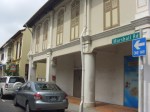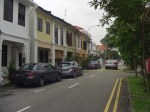Joo Chiat estate, is today located in two areas, Marine Parade and Geylang. It is named after the late Chew Joo Chiat (b. 1857, China – d. 5 February 1926, Singapore), who used to own coconut plantations in the area. The history of the area can be traced back to the regional sea trade activity at the original southeastern coastline of Singapore. Often considered an upper-class area associated with the Eurasian and Peranakan communities, Joo Chiat was actually a multicultural collection of villages considered the poor man’s district compared to the more affluent Katong of the 1920s-1930s.
Community
The different communities in the areas added different flavours to the estate. Malay fishermen’s villages lined the beaches, explaining the colloquial names of streets reminiscent of seafood used in Malay dishes like Jalan Tambam (the fish traditionally used in nasi lemak) and Jalan Sotong. Chinese fruit plantations gave rise to names based on local fruits like Pulasan Road, Rambai Road, Duku Road and Rambutan Road. The Indian community, who sold goat’s milk house to house, still have a 100-year-old temple sitting at Ceylon Road. The British also used a simple alphabetical system to help the less educated locate roads, thus the names Lorong K, L, M and N.
Today
Today, the conserved Chinese shophouses, and the detached and terraced Peranakan houses of delightful colours and with pretty and ornate carvings and tiling, are fine examples of Singapore eclectic architecture. Joo Chiat Road itself is lined with a lot of these quaint buildings. The 1.4km-long Joo Chiat Road is today one of Singapore’s most memorable and historic streets. The road stretches between Changi Road/Geylang Road and Marine Parade Road. The area is also famous for its food. Joo Chiat was and still is an important part of Katong.
https://katonghomes.com/2014/08/05/joo-chiatkatong-trail-the-peranakan-heritage/











Am looking for a funding developer because am into real estate.
Thanks alot
+254722984381
Millycent Eshuchi